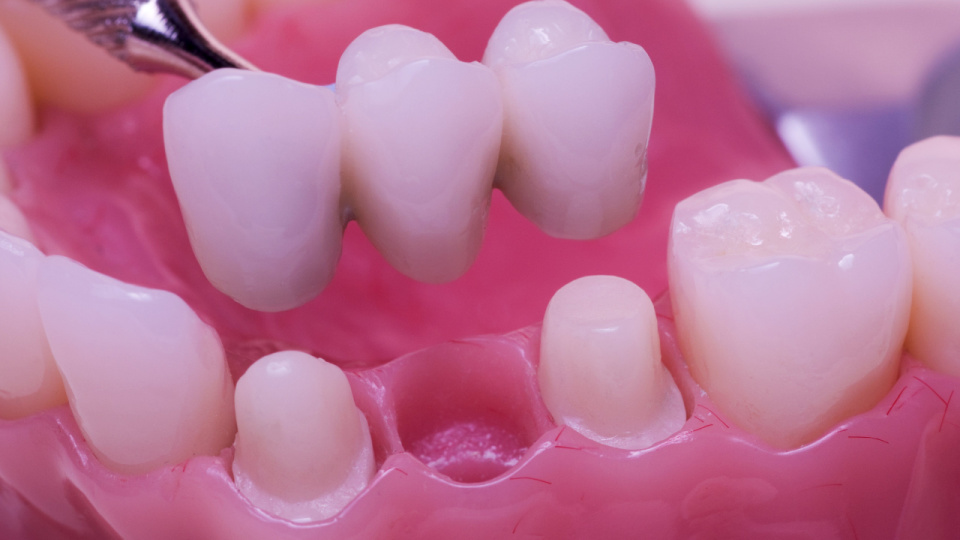Dental Bridge
Dental Treatments
Dental bridge is prosthetic device. It is used to replace one or more missing teeth. The prosthesis consists of a crown (implant or metal wings) on each side of the gap.
Table of Contents
Most Popular Clinics for Dental Bridge
- 912 Reviews 4,7/5
So What is a Dental Bridge?
- Dental bridge is a construction of two crowns. Artificial teeth are placed between the crowns.
- Dental bridges are non-removable prosthetics. So, they cannot be removed by themselves without the help of a dentist. They replace the missing teeth in the middle part and are fixed to the abutment teeth.
- The main design details are artificial teeth and retainers that securely attach the bridge to the mouth.
- The attachments of the bridge can be direct dental crowns, abutments, inlays and clips. In some cases, a gingival imitating element completes the design.
Types and Methods
Traditional Bridge:
The missing space is filled with crowns on the healthy teeth on both sides of the missing tooth.
These crowns support the artificial tooth.
This is the most common type of dental bridge.
It is durable and long-lasting.
Neighbouring teeth should be cut and reduced.
Maryland Dental Bridge:
It consists of one missing tooth. It is connected to the neighbouring teeth with metal wings or tooth-colored adhesives.
There is no need to cut neighbouring teeth.
It has a more aesthetic appearance.
It is less durable than a traditional bridge.
It is usually used for front teeth.
Implant supported Bridge:
An implant is placed in the missing tooth and a crown or bridge attached.
The missing gap is filled without damaging the neighbouring teeth.
It is the most durable and strongest type of bridge.
It is more expensive.
It can take longer to fit.

Dental bridges are classified according to material and manufacturing technology. The raw materials for bridges can be:
- metal
- cermet
- ceramics
- zirconium dioxide
- polymers

Treatment Plan
1. Day:
- Personal consultation with your doctor in the clinic and detailed teeth examination. Tooth root vitality and stability are checked. To have a dental bridge, your abutment teeth must be strong and have healthy roots. They must support the bridge. Your gums and jawbone must be free of inflammation.
- Panorama X-ray of your teeth
- Before and after pictures digital simulation
- Choosing the color and material of the bridge
- Teeth measuring is done to prepare dental bridge accordingly. An impression is taken for this purpose. The dental technician needs this for the accurate fabrication of your dental bridge.
- Preparation of the teeth for the placement of the dental bridge. Preparation of the pontic teeth for the insertion of the bridge. The bridge abutment teeth will be prepared and crowned. The procedure is done under local anaesthetic, so you will not feel any pain.The procedure is performed under local anesthesia, so you will not feel any pain.
- Until the new bridge is ready, you will receive a temporary dental bridge.
- Afterward, you can relax, rest in the hotel and enjoy the Spa!
2. Day:
- Your new dental bridge is ready now!
- Removal of the temporary bridge
- Thorough cleaning of the tooth
- Insertion and fixation of the new dental bridge
- Checking if the bridge causes any pressure or pain and correcting it if necessary.
- You will not feel any pain because of the local anesthesia.
Take a look in the mirror now! Are you amazed by your new teeth?
- Final interview with your doctor. They will inform you about what you should do for the next few days.
- Your treatment is finished.
Dental Bridges for:
- Anyone who wants to restore the appearance and function of their dentures
- Anyone with strong, healthy teeth on both sides of a missing tooth
Dental Bridges Recovery Timeline:
- After a few days, any minor pain caused by bridge placement should disappear.
Possible risks for Dental Bridge:
- Infection
- Scarring
- Allergic reaction to anesthetic or restorative material
- Increased risk of decay of abutment teeth
- Pulp damage or death from tooth loss
Aftercare
Of course, we will also take care of you after your treatment!
Our medical consultants will take care of you during 1 year after the surgery.
If you need any assistance, if you have questions, you can contact our staff anytime.
Dental Bridge Healing Process
The healing process will not take a long time.
Procedure is done under local anaesthetic so you will not feel any pain. There may be some sensitivity in your mouth for the first few days after the new bridge. But this can be easily treated with common painkillers and will disappear quickly.
You shouldn’t eat anything until the local anaesthetic has completely worn off. Otherwise you can bite yourself.
Oral hygiene and regular brushing are very important. Take care of your teeth as usual. You should use dental floss to remove all food particles.

Top dental bridge costs by country
Dental bridge costs can change. It depends on the dentist experience, the brand and material used and the clinic or hospital.
The prices listed below are not a final quotation. Your MedClincs consultant will be happy to provide you with details.
| Country | Price | Rating |
| Turkey | ~ 200 € | ★★★★★ |
| Mexico | ~ 300 € | ★★★★ |
| UK | ~ 600 € | ★★★ |
| Russia | ~ 650 € | ★★★ |
| USA | ~ 1100 € | ★★★ |
| Australia | ~ 2000 € | ★★★ |
FAQ
Why is a dental bridge cheaper in Turkey?
In Turkey, salary and living costs are lower than in Europe, and the government subsidizes the health sector. Therefore, dental treatment in Turkey can be done at a much lower cost without sacrificing quality and standard.
Is it safe to have dental treatment in Turkey?
With over 1.5 million medical tourists per year, Turkey is one of the three world leaders in health tourism. The healthcare system in Turkey is strictly monitored and regulated to ensure the best quality and highest standard of treatments. Experienced doctors together with a professional team take care of the patients in a professional and competent way. It is safe to undergo dental treatment in Turkey.
What are the advantages of dental treatment in Turkey?
You save money and costs, benefit from international quality and avoid long waiting times. In Turkey, you get the appointment for your dental treatment at short notice, in Germany you have to wait weeks. Our contract clinics work closely with laboratories and dental technicians, some of them have their own laboratories. Thus, the production of dental bridges in just a few days is no problem. The short flight time from Europe is another advantage.
Are there good dentists in Turkey?
Turkey is one of the best countries for dental treatment. On the list of top ten dental tourism countries, Turkey ranks fourth after Poland, Hungary and the Czech Republic. With approximately 86 million population, Turkey ranks 17th in the world in terms of population. Doctors have a lot of practical experience compared to other countries, which makes them competent professionals.
What are the equipment of the clinics where dental treatment is done in Turkey?
Our clinics offer the comfort of a 5-star, high-class hotel. The medical equipment meets international standards of the highest level. Across Turkey, 600 clinics have been awarded the coveted JCI certificate, which attests to safe and effective treatment methods, structured working methods and comfortable conditions. In comparison, fewer than 10 clinics in Germany hold this certificate.
Is dental bridge treatment painful?
Since the procedure is performed under local anaesthesia, you will not feel any pain. You may experience some sensitivity in the mouth area for the first few days after the new bridge is placed. However, this can be easily handled with conventional painkillers.
How long do dental bridges last?
The durability of a dental bridge depends primarily on the material used. Oral hygiene and regular brushing and flossing also have an effect. As a rule, it can be estimated that bridges will last for at least 10 years on average.
When do I need a dental bridge?
Dental bridges are used to close a gap between two healthy teeth. To ensure the stability of the dental bridge, one missing tooth, at most two, is usually bridged over. If more teeth are missing, implants are a good option.
What is a dental bridge consist of?
The healthy teeth to the right and left of the gap that support the bridge are called abutment teeth. These teeth are crowned and in their middle is a false tooth, that fills the gap.
When can I see the result?
Are you curious about how your teeth look with your new bridge? Just take a look in the mirror! The result is IMMEDIATELY visible! You will leave our clinic with the perfectly aesthetic teeth you have always dreamed of!
History
Dental prosthetics have been known since BC.
- During the excavations of the ancient city of Sidon (III-IV centuries BC), artificial teeth were also found in the woman’s coffin, which could be called the prototype of modern bridges. Fastening of artificial teeth with gold wire, as well as threads from other materials, are among the earliest methods of fixing prostheses.
- In the tombs of the Etruscans (IX-VI centuries BC), more modern gold prostheses were found, reinforced with gold rings or stripes. In the Roman Laws of the Twelve Tables (5th century BC), there are indications of the use of gold wire for splinting.
- The 11th century Arab physician Abulkasem (936-1013) rightly assessed dental prosthetics as a medical science.
- Giovani Arkone (early 15th century) filled cavities with sheet gold.
- Ambroise Paré (1517-1590, Paris) is a 16th century surgeon – he replaced missing teeth with artificial ones made of bovine or ivory, reinforcing them with gold wire. He made the first attempt to replace the defects of the hard palate with an obturator.
- In 1728 – Pierre Fauchard’s guide to dentistry “Dental surgery or a treatise on teeth” was published. He was responsible for the development of a method for attaching complete removable dentures with springs, he improved the palatal obturator by connecting it to the prosthesis.
Types of Treatments
Find the best Treatments and most Popular Dentists & Clinics
Request Form
Get your free consultation
- Need guidance and reassurance?
- Talk to a real person from MedClinics!
- Let's find the perfect doctor together.
